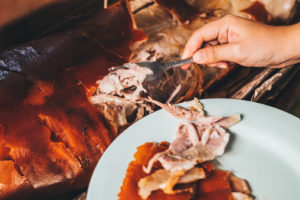Foreigners won’t have a hard time communicating in English since this is considered as the second language of Filipinos and spoken by many. Your Filipino counterpart will pick out some words you said to get the gist of your message. Don’t expect them to be fluent in carrying out a conversation but they will do their best to reply in “Taglish,” a combination of Tagalog and English. Then the fun begins as he tries to explain his point with some body language along with misused English words. Don’t worry when you can’t keep yourself from laughing, Filipinos are friendly and hospitable people, they will enjoy every moment of the conversation and so will you.
Markets showcase a variety of products and goods that are used in concoctingfood for your daily intake. We guide you to the most common words and phrases that are spoken by Filipinos in the marketplace.
1) Some regularly used terms for products or goods being sold:
|
ENGLISH |
TAGALOG |
|
Fish |
Isda |
| Chicken |
Manok |
|
Beef |
Baka |
| Pork |
Baboy |
|
Meat |
Karne |
| Shrimp |
Hipon |
|
Vegetable |
Gulay |
| Fruits |
Prutas |
|
Pepper |
Paminta |
| Salt |
Asin |
|
Cooking Oil |
Mantika |
| Sugar |
Asukal |
|
Fish Sauce |
Patis |
| Soy Sauce |
Toyo |
|
Vinegar |
Suka |
| Bread |
Tinapay |
2) Tindera
A salesperson manning the stall, usually, they are owners.
3) Suki
This means a frequent or loyal customer who buys merchandise from a vendor. The “tindera” don’t know your name, they will call you “suki” to attract attention and to sweet talk you to buy their products.
4) Magkano po ito?
In English, this means “How much is this?” This is used when you want to know the price of an item that you want to buy. Combine this with the list in item 1 and you’ll be clearly understood by the “tindera.”
| TAGALOG | ENGLISH |
| Magkano po itong isda? | How much is the fish? |
| Magkano po itong manok? | How much is the chicken? |
| Magkano po itong gulay? | How much is the vegetable? |
| Magkano po itong asin? | How much is the salt? |
| Magkano po itong tinapay? | How much is the bread? |
5) Pabili po nito?
In English, this means “Can I buy this?” This expresses your desire to buy an item that the “tindera’ is selling. After asking the price you are interested in buying the item, combine this with products mentioned in item 1 and you’re on your way to a successful purchase.
|
TAGALOG |
ENGLISH |
| Pabili po nitong baboy. |
Can I buy some pork? |
|
Pabilipo nitong karneng baka. |
Can I buy some meat of a cow? |
| Pabili po nitong prutas. |
Can I buy some fruits? |
|
Pabili po nitong mantika. |
Can I buy some cooking oil? |
| Pabili po nitong paminta. |
Can I buy some pepper? |
6) Wala na po bang tawad?
In English, this means “Do you give discounts?” It is innate in Filipinos to ask for markdowns even if the price is fair, so just follow this lead, cross your fingers and ask for a discount.
7) Magkano po ang lahat?
In English, this means “How much for everything?” A vegetable vendor sell different kinds of vegetable and a meat retailer can sell beef, pork, and chicken. So after completing your order and you’re about to wrap-up you ask the “tindera’ “magkano po ang lahat?”
Sources and citations:
Learn Tagalog: http://learn-tagalog.com/lesson-9-market/#Exercise_6_Say_in_Filipino




